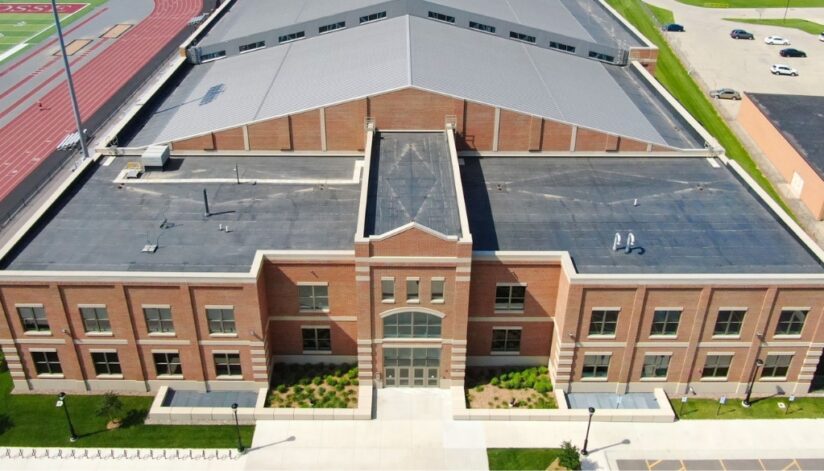Flat Roof Care During Cold Months
Flat roofs are common in commercial buildings, providing practical space for equipment and often being more affordable to install. However, they require particular care during the cold months when freezing temperatures and heavy snow can cause damage. Proper maintenance is crucial to prevent costly repairs and extend the life of your roof. Here’s what you need to know about maintaining your flat roof during the winter in the La Crosse, Wisconsin area.
Regular Inspections Before Winter
Before the freezing temperatures hit, it’s essential to schedule a roof inspection. A professional roofer can check for any cracks, blisters, or other signs of damage that may worsen when exposed to cold weather. Specifically, check for:
- Cracks and Leaks: Even small cracks in a flat roof can lead to leaks when snow or ice melts and seeps into the cracks. These need to be repaired immediately.
- Pooling Water: Flat roofs are prone to water pooling, especially after rain or melting snow. If there are areas where water collects, this can lead to ice formation, which can increase the risk of leaks. Your roofer can recommend solutions to improve drainage if needed.
Keep The Roof Clear Of Snow And Debris
Snow accumulation on flat roofs is a serious concern. Flat roofs can’t shed snow like pitched roofs, meaning the weight of snow can cause stress on the roofing material. During winter, regularly remove snow to prevent structural damage. Here’s how:
- Use a Roof Rake: Invest in a roof rake, a long-handled tool designed to remove snow without damaging the roof. This is particularly important after heavy snowfalls.
- Avoid DIY Snow Removal: Don’t attempt to shovel snow off the roof yourself, as this could lead to damage or injury. If the snow load is heavy, consider hiring a professional snow removal service.
Also, keep the roof free of debris like leaves, branches, and dirt. These can block drainage systems and lead to pooling water, which is more likely to freeze in winter conditions.
Ensure Proper Drainage
Flat roofs rely on an efficient drainage system to prevent standing water, which can freeze and cause damage. Snowmelt and ice can block drains and gutters, so it’s crucial to maintain clear drainage systems:
- Check Drains and Gutters: Ensure that all drains and gutters are free from blockages. Ice dams can form if water has nowhere to go, leading to roof damage.
- Heat Cables: Installing heat cables in the gutters can help prevent ice dams by keeping the drainage systems warm enough to allow snowmelt to flow freely.
- Gutter Guards: Consider installing gutter guards to keep leaves and other debris from clogging your gutters, especially in the fall, as a pre-winter preventative measure.
Address Ice Dams Immediately
Ice dams form when the snow melts on the warmer parts of the roof but refreezes at the colder edges, creating a dam that prevents additional snowmelt from draining off. These ice dams can cause serious damage to flat roofs, including leaks and structural damage.
- Improve Insulation and Ventilation: One of the best ways to prevent ice dams is by improving insulation and ventilation in your building. A well-insulated roof keeps the interior warmer, reducing the temperature difference between the roof and the exterior.
- Install Heat Tape: Heat tape can be installed along the edges of the roof to prevent ice dam formation. This is especially useful in areas that are prone to frequent snow and freeze-thaw cycles.
Monitor Roof Traffic
During winter, foot traffic on your flat roof can increase as maintenance workers check on HVAC systems, solar panels, or other roof-installed equipment. However, the cold weather can make the roof more vulnerable to damage.
- Create Designated Walkways: Install protective walkways made from rubber mats or other non-slip materials to prevent damage to the roof’s surface.
- Limit Traffic: Minimize the number of people walking on the roof during the winter months. If maintenance is required, ensure the crew knows to use caution to avoid creating punctures or tears in the roofing membrane.
Prevent Thermal Shock
Thermal shock occurs when extreme temperature changes cause materials to expand and contract rapidly. This is particularly problematic for flat roofs in areas like Wisconsin, where winter days can have significant temperature fluctuations. To minimize the risk of thermal shock:
- Use Flexible Roofing Materials: If you’re considering a roof replacement or upgrade, opt for materials that can expand and contract with temperature changes without cracking.
- Apply Roof Coatings: Roof coatings can provide a protective layer that prevents damage from temperature shifts, helping to reduce the effects of thermal shock.
The Importance Of Proactive Flat Roof Maintenance
Flat roof maintenance during cold months isn’t just about reacting to problems; it’s about preventing them. Regular inspections and proactive care can prevent small issues from becoming major concerns that disrupt business operations. Additionally, working with an experienced roofing professional ensures that any damage is detected and addressed before the snow starts to pile up.
The Ledegar Roofing Advantage
At Ledegar Roofing, we’re here to help maintain flat commercial roofs in La Crosse and surrounding areas. Our team of experts understands the challenges of Wisconsin’s harsh winters and is here to provide professional inspections, snow removal, and repair services to keep your flat roof in top condition. Contact us today for a free consultation and learn how we can help protect your business through the winter months.

